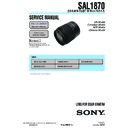Sony DSLR-A300K (serv.man2) Service Manual ▷ View online
4-12
SAL1870 (3.5-5.6/18-70) (DT 18-70mm F3.5-5.6)
4-4.
FOCUS-SHIFT/FLANGE BACK (f’F) CHECK/ADJUSTMENT
4-4-1. Focus-shift/Flange Back (f’F) Check
Equipment
• 1000 mm Collimator
• Flange Back Tester
• A-mount Attachment
• Flange Back Gauge (43.50mm)
1. Preparations
1)
Set the equipments as shown in the Fig.4-4-1.
Fig.4-4-1
2)
Looking through the eyepiece lens, turn the eyepiece ring of the flange back tester so that cross line or scale in the view is the sharpest.
3)
Attach the flange back gauge (43.50mm) securely to the A-mount attachment and hold them together.
4)
Turn the focusing knob of the flange back tester so that fine scratches on the flange back gauge (43.50mm) is the sharpest.
Note:
Turn the knob in the direction of the arrow of Fig.4-4-2 for correct reading.
Fig.4-4-2
5)
Turn the scale ring of the dial gauge until the long pointer indicates “0”.
Note:
This position is the flange back (f’F) = 43.50 mm.
Memorize the position of short-pointer.
flange back gauge (43.50mm)
A-mount attachment
Objective lens (10x)
Dial Gauge (Min. scale: 0.01 mm)
Scale ring
Eyepiece lens (7x)
Eyepiece ring
Focusing knob
Focus on fine lines on the surface.
Always turn the knob in the arrow
direction for correct reading.
direction for correct reading.
4-13
SAL1870 (3.5-5.6/18-70) (DT 18-70mm F3.5-5.6)
Optical Alignment
Best alignment
Best alignment
Incorrect aligned
e.g. As the focusing knob is turned, the chart may appear blurry as illustrated.
The cause depends on individual lens.
e.g. As the focusing knob is turned, the chart may appear blurry as illustrated.
The cause depends on individual lens.
2. Checking Method
1)
Attach the checking lens to the flange back tester, and set the 1000 mm collimator.
Fig.4-4-3
2)
Set the focus ring of the checking lens to infinity end position while looking through the microscope, and align the optical axis to the
center of the chart image accurately.
3)
Turn the focusing knob of the tester until the chart image is the sharpest (red and green color areas are equal on the chart *).
*: Position in which the color of collimator chart changes from green into red and come into focus.
Also check the optical axis aligns with the chart center. (Refer to Fig.4-4-4.)
Note:
Figure shows example. The cause depends on individual lens.
Fig.4-4-4
4)
Calculate the flange back (f’F) of the checking lens using the following formula, and check that the specification of the Table 4-4-1 is
satisfied.
Flange back (f’F) of the checking lens = (Flange back gauge) + (Number of short-pointer revolution) + (Reading of long-pointer)
Specification
Focal-length
f’F (mm)
f (mm)
(Infinity position)
18
44.65 to 44.85
70
46.33 to 46.63
Table 4-4-1
5)
When the flange back (f’F) of the checking lens is out of specification of the Table 4-4-1, perform “4-4-2. Focus-shift/Flange Back
(f’F) Adjustment”.
1000 mm collimator
Checking lens
4-14
SAL1870 (3.5-5.6/18-70) (DT 18-70mm F3.5-5.6)
4-4-2. Focus-shift/Flange Back (f’F) Adjustment
Equipment
• 1000 mm Collimator
• Flange Back Tester
• A-mount Attachment
• Flange Back Gauge (43.50mm)
• Adhesive bond (B-10)
1. Preparations
1)
Remove the zoom rubber ring.
Fig.4-4-5
Adjusting Method
1)
Turn the knob of the flange back tester, and set the dial gauge value to “46.48 mm” referring to “4-4-1. Focus-shift/Flange Back (f’F)
Check”.
2)
Set the zoom ring of the checking lens to Tele end position (focal length: 70 mm).
3)
Loosen the two screws fixing the focus stopper, and turn the focus ring so that the chart image is the sharpest. (Refer to Fig.4-4-6.)
4)
Set the focus stopper until it stops in arrow direction while holding the focus ring, and tighten the two screws. (Refer to Fig.4-4-6.)
Fig.4-4-6
5)
Set the zoom ring of the checking lens to Wide end position (focal length: 18 mm).
6)
Turn the knob of the flange back tester until the chart image is the sharpest while looking through the microscope.
This flange back (f’F) is f’w.
7)
Calculate focus error amount using the following formula.
Focus error amount = Flange back (f’w) reading - 44.72 mm
Focus error amount: Amount that should be adjusted by the back adjustment washer thickness.
f’w:
Flange back value (Reading value) at zoom ring is Wide end (focal length: 18 mm), and focus ring is position
of step 4).
Two screws
Focus Ring
Focus Stopper
Set the focus stopper
until it stops in arrow direction.
until it stops in arrow direction.
Zoom Rubber Ring
4-15
SAL1870 (3.5-5.6/18-70) (DT 18-70mm F3.5-5.6)
Table 4-4-2
Fig.4-4-7
10) Install the back adjustment washer and coupler adjustment washer, and perform “4-4-1. Focus-shift/Flange Back (f’F) Check” again.
11) After the adjustment is completed, apply the adhesive bond (B-10) to the position shown in the Fig.4-4-8.
Fig.4-4-8
Back adjustment washer
Parts No.
T (mm)
A
2-683-648-01
0.05
B
2-683-649-01
0.07
C
2-683-650-01
0.1
D
2-683-651-01
0.2
E
2-683-652-01
0.5
8)
Adjust the back adjustment washer thickness according to the result of step 7). (Refer to Table 4-4-2 and Fig.4-4-7.)
Note:
Use the micrometer gauge (or slide gauge) to measure the back adjustment washer thickness.
If focus error is a negative value: Decrease back adjustment washer thickness by error amount to increase flange back.
If focus error is a positive value: Increase back adjustment washer thickness by error amount to decrease flange back.
9)
Change the coupler adjustment washer thickness to the back adjustment washer thickness. (Refer to Table 4-4-2 and Fig.4-4-7.)
Coupler adjustment washer thickness = Back adjustment washer thickness
Coupler adjustment washer
Parts No.
T (mm)
A
2-683-641-01
0.05
B
2-683-642-01
0.07
C
2-683-643-01
0.1
D
2-683-644-01
0.2
E
2-683-645-01
0.5
Back Adjustment Washer
Coupler Adjustment Washer
Apply the
adhesive
bond (B-10)
adhesive
bond (B-10)
Two screws
Focus Ring
Focus Stopper
Click on the first or last page to see other DSLR-A300K (serv.man2) service manuals if exist.

